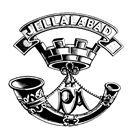
Bernard Walter Gould

8th Battalion
Private 20620
 |  | |
| Somerset Light Infantry 8th Battalion Private 20620 | ||
| Died 27th April 1917 |
Walter Gould's Parents | ||
| Bernard Walter Gould (known as Walter) appears to have been the
youngest of 12 children born to Frederick Gould and Anna Maria (née Clark) in the Midsomer Norton area. The
Gould/Clark name combination of his parents is slightly confusing because it
was not unique in the Midsomer Norton area at the time of the family having
their children, but we know who Walter’s
parents were and, through a combination of census information and Methodist baptism records, we
believe we are able to apportion other births to the correct family. Walter’s father, Frederick Gould, grew up in Ashwick and Downside, Somerset, as one of 8 children in a family whose head (Frederick senior) was an engine driver hauling coal, at a time when northern Somerset was a significant coal-producing area. Frederick (junior) himself then worked as a coal miner and is listed as such, aged 15, in the 1861 census. In 1871 he was still mining coal and living with his parents at Ashwick. Walter’s mother was Anna Maria (née Clark), who grew up in a family of agricultural labourers (both parents and also her elder brothers were farm workers) in Pensford. In 1871 she was a boarder at premises in Wells Rd, Bedminster, Bristol, which was also home to a tobacconists shop run by a Mr Gordon. This would have been near the Three Lamps junction, but no shops survive in this area today. | ||
The Gould Family |
| Frederick
& Anna married in 1874 in Clutton. |
 |
|
It seems Frederick & Anna had 12 children, all registered in the Midsomer Norton district. The 1881 census lists the family in ‘Green Ditch’, a lane to the west of Chilcompton, which is within the Midsomer Norton area. Walter was the last of these twelve children and his place of birth is also listed as Chilcompton in some sources. Walter’s mother Anna died in 1899, when Walter was just 4. At some time subsequent to that, his father Frederick came to live in Twerton (one supposes he brought Walter with him) as we know that Frederick died in Twerton parish in 1909.Walter was thereby orphaned at the age of about
14.
In the 1911 census, Walter was listed as an Errand Boy. |
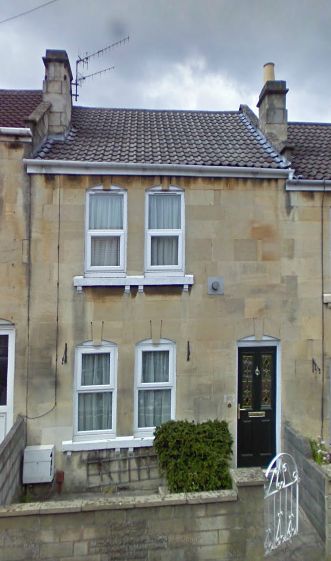 | ||
|
15 Herbert Road, where Walter Gould lived with his aunt & uncle following the death of his parents |
Walter Gould in WW1 | ||
Somerset Light Infantry
Walter enlisted with the 8th Battalion of the Somerset Light Infantry with the serial number 20620, meaning that he joined up prior to Albert Hole, but we assume that they served together. The 8th Battalion of the SLI was raised in October 1914 and initial training took place in Leighton Buzzard. In terms of active service, 8th SLI were with 63rd Brigade, (21st Division) until July 1916, then with 37th Division. 63rd Brigade landed at Le Havre on 10th September 1915. (More details pending). | ||
Walter Gould's Death | ||
Having apparently lived through the very unsuccessful 63rd Brigade attack on Greenland Hill (near Fampoux) on 23rd/24th April (in which Albert Hole died), Walter appears to have died in the following days. The 8th Somersets casualty returns for
the period 20th - 29th April were combined as they were in the front line for
the duration of this time and the Regimental History on page 184 notes that
losses were: 2 Officers and 17 O/R killed, 4 Officers and 180 wounded and 99 O/R
missing. | ||
Burial | ||
| Walter Gould is buried in St Nicolas Cemetery (Plot I, grave H5) From the Commonwealth War Graves Commission: "From
March 1916 to the Armistice, the village of St. Nicolas was occupied by
Commonwealth forces and for much of that time it was within the range of German
artillery fire. The cemetery was started in March 1917 and used by the
divisions and field ambulances stationed there until October 1918." | ||
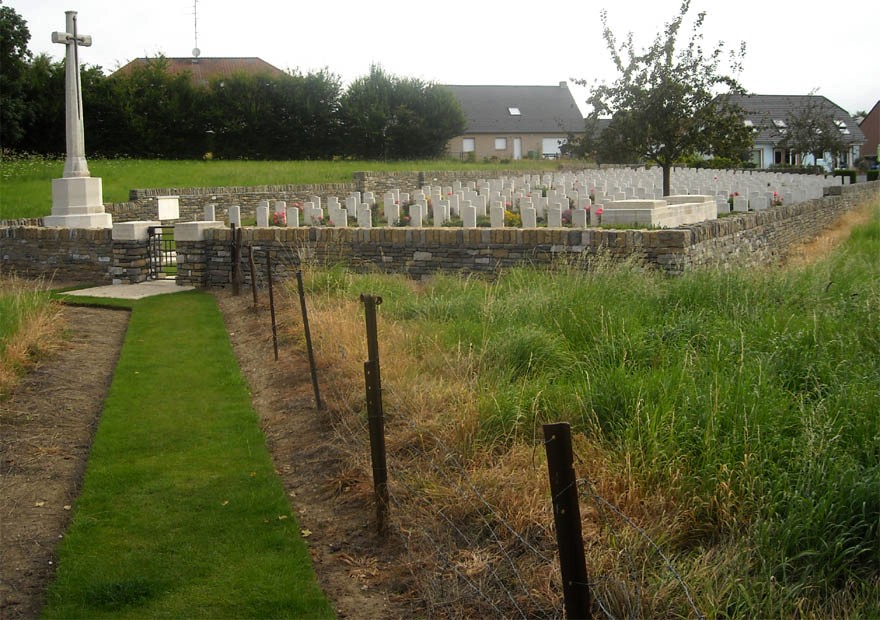 St Nicolas cemetery [Image: www.cwgc.org] | ||
St Nicolas cemetery was sought out in 2017 by Mike Sumsion, who has regularly travelled from Bath to the Western Front and visits the graves of Bath's fallen WW1 servicemen. It is good to know that the connection with these men's home city is being preserved in this small but important way. Mike has kindly supplied a photograph of Walter's grave: 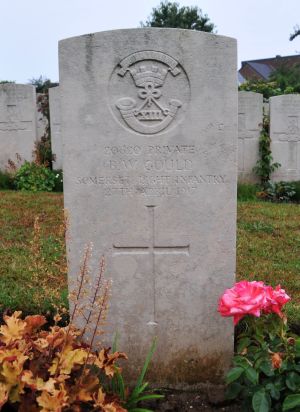 |
Decoration |
|
Walter Gould's medal card does not survive. Although we know that the 8th SLI, with 63rd Brigade, reached France in September 1915, Walter Gould's comrade Albert Hole's medal card did not include reference to the 1914-15 Star, so we assume that Walter Gould also received the British War Medal 1914-18 and the Allied Victory Medal posthumously. |
 | 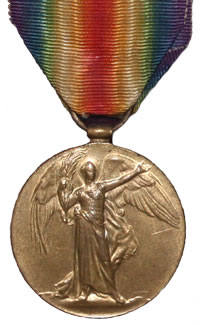 | ||
| British War Medal 1914-18 | Allied Victory Medal |
Commemoration | ||
 In addition to his commemoration on the South Twerton School memorial, Walter Gould is commemorated as follows: | ||
|
Bath War Memorial Walter Gould
is not listed on Bath War Memorial but, given that he lived in Herbert
Road for several years and attended South Twerton School, we believe
that he
should be listed. We are in the process of investigating this omission,
along with other
such cases we have identified. |
|
Somerset Light Infantry, 8th Battalion Memorial (Bath Abbey) The Colours of the 8th Battalion can be seen
today in Bath Abbey. They were presented to the Battalion – after Walter’s
death – to be carried on the final push towards Germany and then later
deposited in the Abbey as a tribute to the fallen. Sadly, the plaque - supposed to be a memorial tribute to men who gave their lives - is partly obscured by straps and wires relating to the Abbey's flat screen TV system. With a little more care, these could have been placed in a way that did not interfere with the view of the plaque. Indeed, the Abbey is currently doing a fairly poor job with several of its WW1 memorials:
|
| The Colours displayed in the Abbey were never seen in battle by Walter Gould or Albert Hole, as they were presented to the Battalion in February 1919, after the end of the war. As such, the Colours were presented as a symbol of recognition for the sacrifices made by the Battalion. Some of these are detailed in the reports of proceedings of the deposition. A curious example is in the item below, from the Bath Chronicle & Weekly Gazette of 30th July 1919, in which it is asserted that soldiers from the 8th SLI surprised the Germans by going over the top dressed in football kit: |
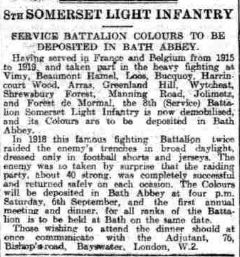 | ||
|
Taunton Courier, July 1919: 8th SOMERSET LIGHT INFANTRY SERVICE BATTALION COLOURS TO BE DEPOSITED IN BATH ABBEY Having served in France & Belgium from 1915 to 1919 and taken part in the heavy fighting at Vimy, Beaumont Hamel, Loos, Bacquoy, Harrincourt Wood, Arras, Greenland Hill, Wytcheat, Shrewsbury Forest, Manning Road, Jolimetz and Forest de Mormal, the 8th (Service) Battalion Somerset Light Infantry is now demobilized and its Colours are to be deposited in Bath Abbey. In 1918 this famous fighting Battalion twice raided the enemy's trenches in broad daylight, dressed only in football shorts and jerseys. The enemy was so taken by surprise that the raiding party, about 40 strong, was completely successful and returned safely on each occasion. The Colours will be deposited in Bath Abbey at four p.m. Saturday 6th September, and the first annual meetnig and dinner, for all ranks of the Battalion is to be held at Bath on the same date. Those wishing to attend the dinner should at once communicate with the Adjutant, 76 Bishop's Rd, Bayswater, London W2. |
|
The following article appeared in the Bath Chronicle &
Weekly Gazette on 6th September 1919, describing the service surrounding
the placement of the Colours in the Abbey: THE 8th SOMERSETS' COLOURS. PROGRAMME FOR SATURDAY'S CEREMONY AT THE ABBEY. The following is the programme arranged in connection with the ceremony
attending the return of the Colours of the late 8th Batn. S.L.I., to Bath Abbey
this (Saturday) afternoon: 3.30 The
2nd V.B. Somerset L.I. [Volunteer Battalion, Somerset Light Infantry] with band
will parade in Grand Parade, and march to the station to provide escort for the
Colours. 3.45 Former
officers and men of the 8th Battalion will meet outside the G.W.R. Station.
Colour Party will arrive at G.W.R. Station and will proceed to the Abbey
Church, West door, with band and escort and officers and men of the 8th
Battalion. Lieut. H. K. Austin, M.C., will act as Colour Bearer. 3.45 The
Mayor and Corporation will meet at the Guildhall and proceed, accompanied by
the Lord Lieutenant, General Sir Montague Harper (G.O.C. in C. Southern
Command) and other officers and the Rector to the Abbey, to take their
customary seats, being met at the West door by the Choir. 3.50 The
Rector will proceed to the West door to await the arrival of the Colour Party. 4.0 The
Colour Party, with escort, band and accompanying troops, will arrive in front
of the West door of the Abbey. Major Peard will step forward and order the Party
to present arms, the Band will play 'God Save the King', and the buglers will
sound the 'Last Post'. The Colour Party, officers and men of the 8th Battalion
and troops will then enter the Church and proceed, headed by the Rector, the
band playing " Troop " or dirge.
The Officers will take their seats on the North side of the Chancel,
Major Peard and the Colour Party standing in the space between the choir
stalls. The men of the 8th Battalion will take their seats on the south side of
the middle aisle and the Volunteers on the North side. A hymn will be sung, and
a short service will be held. The Colour Bearer will hand the Colours to Major Peard for presentation
to the Rector who, having accepted them for safe custody, will give them to
vergers to be deposited in their places during the singing of the hymn "O God,
Our Help in Ages Past". The Rector will then give an address. Two verses of "God Save the King " will be sung, the Rector
will pronounce the Blessing and the ‘Last Post’ will be sounded by the buglers,
The officers and men of the 8th Battalion will leave the Abbey first to
form up in Abbey Churchyard. The Mayor and Corporation with the Lord and other
officers, and the Rector will leave the Church and proceed to the front
entrance of the Guildhall, where the salute will be taken. The next Saturday (13th Sept 1919), the newspaper
carried the following photographs of proceedings: |
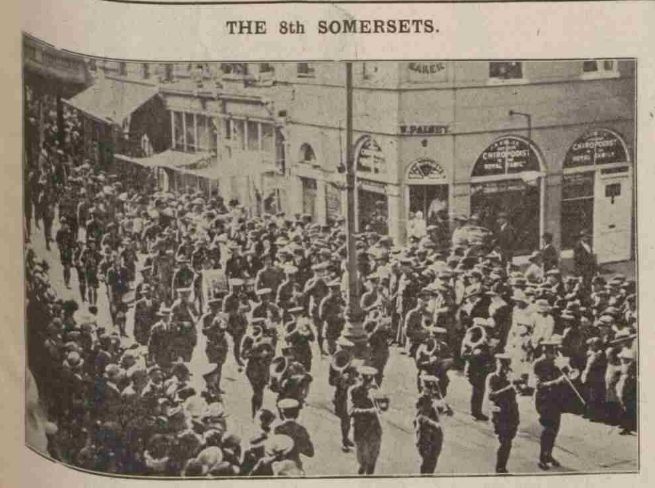 | ||
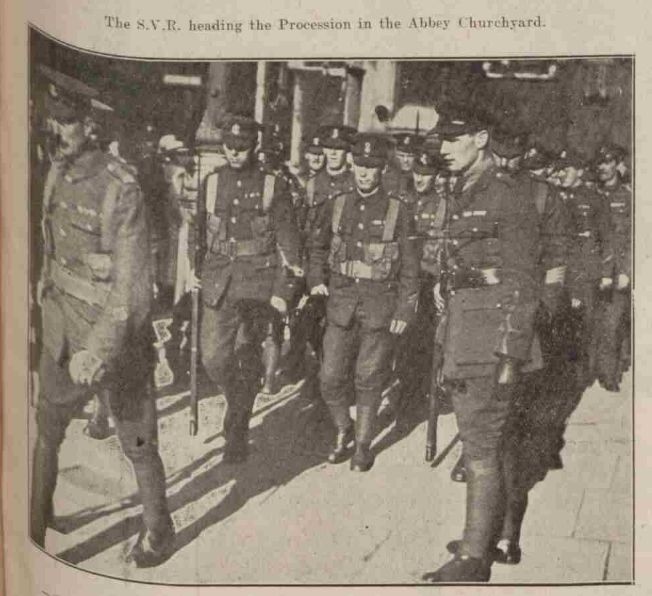 | ||
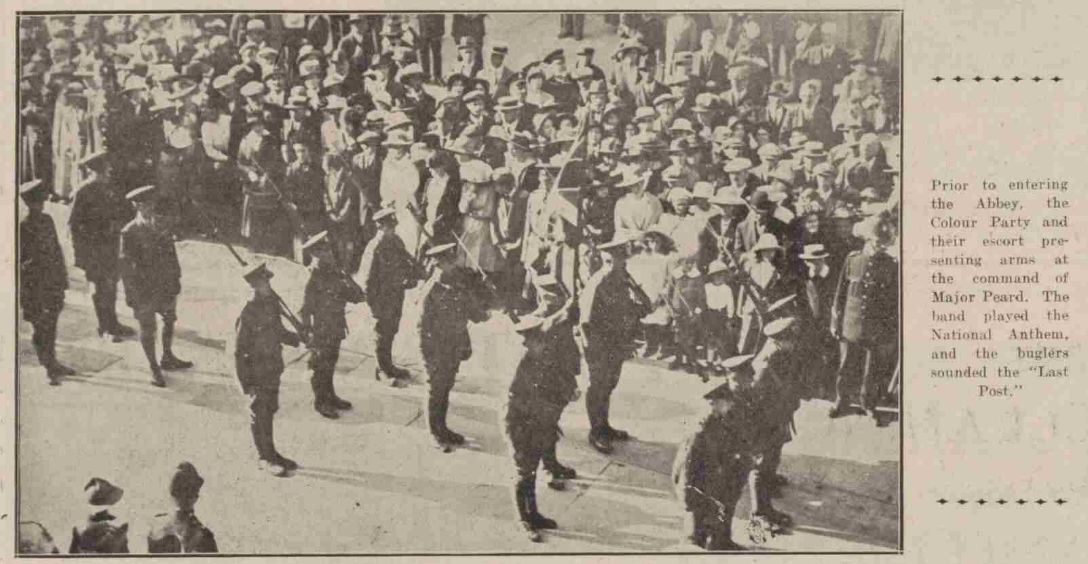 | ||
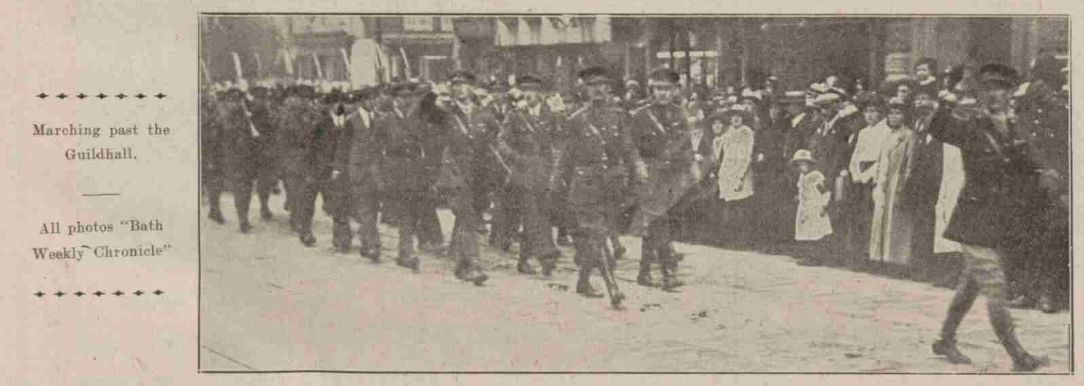 |
|
The report that accompanied these photographs (somewhat abridged)
was as follows: THE 8th SOMERSETS COLOUR DEPOSITED IN BATH ABBEY A MEMORABLE CEREMONY BATTALION’S FINE FIGHTING RECORD With appropriate ceremony, the Colour of the now disbanded 8th Battalion of the Somerset Light Infantry was on Saturday placed in its new and permanent abising-place, on one of the tower pillars of Bath Abbey. Similar events in Bath have been comparatively rare, and every care was taken for the fitting observance of an event of truly far-reaching significance. All classes of the community united in its celebration. For the ceremony was, strictly speaking, more national than local. It was not a mere pageant or pastime for the curious. It was a leaf of contemporary military history – a page of our national roll of honour. This Colour hangs today a silent but eloquent witness to the triumph of a great national ideal. It is the concrete embodiment of principles which meant much to many who have fought and fallen. To their fellow citizens who yet live it will remind as an inspiration and a challenge. The peace beacons on our encircling hills have blazed and turned to ashes; already they are half-forgotten. But to our Abbey has been committed a proud trust – the guardianship of the token of a nation’s ideals. BATTALION’S BRILLIANT RECORD Last week we recorded some of the engagements in which the 8th Somersets gained distinction. A more complete list is: Loos, Armentieres, Friecourt, Beaucourt, monchy-le-Preux, Greenland Hill, Wanebeke, Wylschaete, Ypres, Menin Road, Rossignol Wood, Bacquoy, Achiet-le-Grand, Achiet-le-Petit, Behucourt, Biefvilliers, Gilimetz, Havrincourt Wood, Havrincourt Grand, Arras, River Selle, Beaucourt Hamel, and Mormal Forest. Their casualties were very heavy. This Battalion carried out the first organised raid on enemy trenches on the Western Front. The approximate date of the exploit was towards the end of November 1915. A party of 150 ‘went over’. About twenty of the enemy were killed and eight were made prisoners. AWAITING THE COLOUR Soon after three o’clock the citizens of Bath began to prepare their greeting. Would-be sightseers gathered at convenient points of vantage and the 2nd Battalion of the PASLI [Prince Albert’s Somerset Light Infantry], with band, mustered at 3.30 on the Grand Parade in readiness to escort the Colour Party from the station. There were forty NCOs and men on parade. The bugle band of the 1st North Somerset Troop of Boy Scouts was attached to the band of the PASLI and the other members of the Troop assisted by lining the approach to the Abbey from the Colonnade to the West Door. In the meantime, the Abbey bells began their message of welcome. AT THE GUILDHALL The Mayor (Mr A W Wills), City Councillors, magistrates, clergy and
Army officers assembled at the Guildhall before proceeding to the Abbey. COLOUR PARTY’S ARRIVAL From the station the military procession passed up Manvers Street and
along Terrace Walk and Cheap Street to the Abbey. RECTOR RECEIVED THE COLOUR The civic procession, headed by the City Swordbearer and the
mace-bearers, left the Guildhall and took their allotted places in the Abbey
before the time fixed for the arrival of the Colour party. The Rector of Bath,
attended by the head verger, Mr C S Warwick, awaited the arrival of the Colour
and its escort at the west door. The service in the Abbey had been fixed for four p.m.; but the train
conveying the Colour party from Taunton, due at 3.45 did not arrive till 4.26.
During the period of waiting the organist played various selections. At 4.45
the music of the approaching band was heard by the waiting congregation within the
Abbey and the military procession entered by the west door. The Colour party
consisted of Lieut Barley CSM, F Rocky, Bugle-Major V Calver, CQMS J Mitchell,
Sergt Razey and seven men. Uniforms were very generally worn, but some officers
and a very large proportion of the men wore civilian clothing. Before entering the Abbey, the Colour party presented arms. The band then played the National Anthem, and
the buglers sounded the ‘Last Post’. Within the Abey, seats were reserved for
the military and for relatives of fallen members of the battalion. The Colour party, preceded by the Marquis of Bath as Lord Lieutenant of
the County, passed up the nave to the choir, the band playing a ‘troop’. The
first hymn, sung to the ‘Old Hundredth’ was ‘O King of Kings, Thy blessing
shed’, practically a metrical prayer for the King. Psalm 144 ‘Blessed be the
Lord my strength, who teachest my hands to war, and my fingers to fight’ was
sung and prayer was offered in commemoration of the faithful departed and for
unity at home. Major Peard then presented the Colour to the Rector who, in accepting
it, said “We are proud and glad to receive this Colour and, considering all
that it stands for, will endeavour to guard it well.” During the singing of the
hymn ‘O God our help in ages past’ Mr J N Wake (the tower-master at the Abbey)
placed the Colour in its new position under the tower. THE RECTOR’S ADDRESS [The Rector drew upon Numbers ch17 v10 and the story of Aaron, with its
use of symbols etc.] The beginning of the use of symbols was lost in the mists of the past,
but their convenience was obvious. A man followed a particular calling, or
handicraft, his services were in request and he chose a symbol for it: there
and then the symbol became a token. The Colour of the regiment was a natural
and suitable symbol and it might become a token. So that Colour was both a
symbol and a token. FLAG OF JUSTICE AND FREEDOM And of what did it speak to them? First, it was a British flag, that
flag of justice and freedom that had gone all over the world. Never was isle so
little Never was sea so
lone But over the sand
and the palm trees An English flag
was flown They were proud of the British flag wherever they might be; it was an
unbeaten flag, but far more than that, it was an unsullied flag. The British
flag stood for honour and the colour was the colour of the Somerset Battalion,
which had close associations with the City of Bath. It was presented to the
Battalion in France to be carried into Germany. The 8th Battalion
was formed in the autumn of 1914 and it was, therefore, a genuine volunteer
battalion. It went to France and marched straight to the battle of Loos without
having gone into the trenches. It lost heavily in that battle, Lieut Faland and
Private Saxty being among those who fell. The battalion had seen almost as much
fighting as any unit of Lord Kitchener’s Army – much more than most – and it
was engaged in action right up to the signing of the armistice. Beside Loos,
the battalion took part in the battle of Armentieres, Fricourt (where, in the
battle of the Somme, Captain Hatt fell on July 1st 1916 after having
received the Military Cross). Beaucourt, Ypres, Rossignol Wood and many other
places, earning particular distinction as a fighting force. Its casualty list
through all those numerous engagements was – alas! – grievously heavy both in
officers and men. He believed only two officers who went out with the battalion
returned. It had lost, he understood, many commanding officers. One, a young
officer of most unusual promise and a brilliant leader, Colonel Hardyman, was
killed only last year. More than once the battalion suffered so severely that
it had to be taken out of the line and reformed. That battalion was one of
those specially cared for by Bath and the older men who went out with it and
endured the hardships of the earlier days had, he was told, grateful feelings
towards the ladies of Bath and towards the city generally. Certainly he might
say that the City of Bath and the county had reason to be grateful to and proud
of them. Thus that colour spoke of a spirit that had wrought honour to the
nation. The true glory of any nation was not its wealth, its extensive
dominions or the ability of its able men, but the character of its people. Had
they as a people a high and God-inspired sense of duty? Were they brave? Were
they chivalrous on behalf of others? Then, however small in numbers, these were
a great people. DUTY WELL DONE That colour spoke of duty well done. That battalion had had a hard duty
to do and it was the barest justice to say that they had done it triumphantly
well. The colour also spoke of unflinching courage in the face of danger,
hardship and difficulty. The record of the battalion was sufficient to show the
risks that they ran; they faced death time after time in all sorts of forms
.For four years and more they had experienced hardships which were sufficient
to break down any man’s spirit. It had been a searching and prolonged ordeal.
It was vain for them to attempt to picture what those men had gone through, the
sights they had seen and the strain they had been subjected to. While the war
lasted they all read in their papers the accounts of what was happening, but
how little they could picture of what it was actually like. They could only
thank them from the bottom of their hearts for matchless courage and heroic
endurance; it spoke for chivalrous self-sacrifice. Those men fought and many of
them gave their lives for the cause of their country, the cause of the
oppressed nations, the defence of their homes and of those they loved. It was
that which glorified a just and necessary war such as the late war had been.
They had shown devotion and love to the cause of righteousness, justice,
freedom and the protection of the defenceless and the banner that floated over
that devotion was a banner indeed. ‘Take thy banner, may it wave proudly o’er
the good and brave’. The colour that had just been fixed in position was
remarkable for the short time that it had existed but it was the colour of a
battalion that had fought in an extraordinary and unparalleled crisis. They
must never forget that there were moments during the war when real peril
threatened our Army and nation. In God’s providence they were saved by the
unconquerable spirit of the men who fought with their backs to the wall. It was
the true crisis of their faith, and in all the years that might be to come it
would be remembered, he hoped, that the colour was carried by men who fought in
that memorable struggle to be kept for a token. That was the pious intention of
that service; He husbands best
his life That freely gives it for the public good The first and last verses of the National Anthem were then sung and
after the Blessing the ‘Last Post’ was sounded. GENERAL HARPER TAKES THE SALUTE After the service in the Abbey, the Mayoral party returned to the Guildhall, where they were entertained to tea at the invitation of the Mayor. They then assembled at the principal entrance to the Guildhall while the troops filed past. First came the gallant survivors of the 8th Battalion, then the 2nd Volunteer Battalion PASLI and lastly the Scouts. Lieut General Sir G M Harper took the salute. The celebration concluded with a dinner for officers and men of the old Battalion at the Red House restaurant, New Bond Street, but prior to this reunion, a meeting was held in the Concert Hall at the [old ‘Lower’] Assembly Rooms [Terrace Walk, later the Bath Royal Literary & Scientific Institute], to discuss the proposal to perpetuate the memory of the Battalion by holding an annual dinner. Col. Sheringham presided. The suggestion was unanimously adopted and the meeting then discussed the most suitable date. Three suggestions were made: September 9th, the day on which the Battalion landed in France in 1915; September 29th, or Armistice Day. The nearest Saturday to the particular date would be selected in each case. September 9th was chosen and it was deciced to hold next year’s dinner in Bath. Lieut-General Sir G M Harper sent a message to the meeting, conveying
his best wishes to the all the members of the Battalion and stating how proud
and pleased he had been to attend that afternoon’s ceremony in the Abbey. DINNER AT THE RED HOUSE There was a company of about 140 at the Red House restaurant. Lieut Col
Sheringham presided and a loyal toast list was enthusiastically honoured. There
were selections by Mr H G Brampton’s orchestra and songs by Mr Robert Percival
and other artists. A further, final item from that day’s newspaper was as
follows (again abridged): THE 8th SOMERSETS COLOURS Preb Lloyd’s Notes Writing in this month’s Abbey Notes, Preb. Lloyd says: “The Colour of the late 8th Battalion Somerset Light Infantry will be viewed with interest not unalloyed, however, for it will speak of bitter sorrow to more than one in Bath. On the other hand, the hard and protracted work of the Battalion was a solid contribution to the war. Ceaselessly for more than four years those brave and loyal men responded to the call of duty and though their officers were slain and their numbers woefully reduced, they helped to carry the flag to victory. They have deserved well of their country, and those that have fallen have fallen most gloriously. The battalion was drawn from Somerset but Bath supplied it with notable recruits who brought honour to their regiment. That the Colour should be permanently set up in the Abbey Church is most fitting and the city will be proud of it. The last occasion of the depositing of Colours was May 29th 1908 when the 4th Battalion Somerset Light Infantry was disbanded, the two Colours were brought here and installed at the entrance to the choir. Till then, no Colours hung in the church, so well fitted in every way to receive them. Close
observers may notice that the older Colours have been brought a little lower
down on their columns and inclined a little more obliquely, it having been
pointed out that this would be an improvement. The new Colour has been fixed to
match. As regards the latter, the fact must never suffer oblivion that it was
specifically bestowed in the land of our noble ally France to be carried into
conquered Germany, which it was.” |
Further Information |
Living relativesIt would be great to hear from any living relatives of Walter Gould. As one of twelve children, it is entirely possible that there are living descendants of one of Walter's siblings, of which we know the following:
ThanksThanks to Mr David Carter who supplied the contemporary newspaper photo of Walter Gould.Please get in touch!If you have any further information on Walter Gould, or want to suggest corrections / improvements for this page, please use the Contact page to get in touch.All additions and further information will be credited appropriately. |